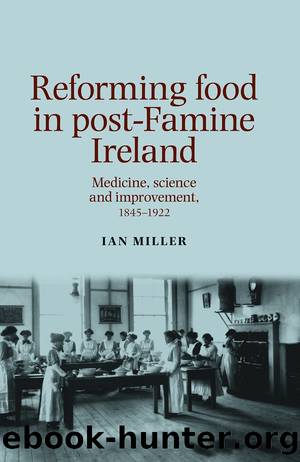Reforming Food in Post-Famine Ireland: Medicine, Science and Improvement, 1845â1922 by Ian Miller

Author:Ian Miller [Miller, Ian]
Language: eng
Format: epub
Tags: Medical, Public Policy, Ireland, Europe, Agriculture & Food Policy, Political Science, History
ISBN: 9781526102638
Google: tW25DwAAQBAJ
Goodreads: 22503356
Publisher: Manchester University Press
Published: 2014-08-20T00:00:00+00:00
Figure 5.3 Number of animals slaughtered at Dublinâs public abattoir, 1884â91.
Similar debates surfaced in Belfast. Concern over diseased meat consumption mounted in the late 1890s. Then, only meat produced in Belfast was liable for inspection in the city. However, rising demand encouraged butchers to retail meat purchased from further afield. This made regulation more difficult. Objections to the cityâs public abattoir persisted and were, perhaps, not entirely unjustified given an ongoing absence of conclusive evidence about the dangers of urban butchering. At a meeting of the Belfast Corporation in 1895, Councillor Masterson argued that scientific alarmists were âfrightening poor, timid peopleâ and insisted that they should moderate their ideas. In contrast, Councillor OâNeill maintained that scientists were not alarmists and, if anything, more meat inspections should be undertaken.49 This illustrative example reveals a continuing diversity of attitudes to the apparent dangers of meat. Whether or not hygienic science was a socially protective force or a false form of knowledge continued to be heavily debated.
Nonetheless, in October 1900 the Belfast Corporation initiated a policy of inspecting all meat killed outside the city to be sold at Belfastâs markets, imposing a sharp fine of up to 40 s. on offenders.50 This resulted in a declining usage of private slaughterhouses external to the city and an increase in the numbers of cattle being processed in the public abattoir â a dramatic rise from 35,273 in 1904 to 59,003 in 1906. In 1909, local authorities proposed that Belfastâs abattoir should be extended to accommodate this demand and fitted with up-to-date technologies and a stomach cleaning depot. This new design allowed up to 200 cattle to be converted into food every ten hours while animals could be killed, bled and dressed in forty-five minutes. An inquiry in 1909 allowed producers to express their objections. At this, Samuel Carson, president of the Belfast Masters Butcher Association, complained that the site rested on top of a disused sewage works and had been built next to a chemical works. In consequence, Carson asserted, he had not once used the abattoir in the previous seventeen years and would be less inclined to do so in light of the proposed modifications. Carson also objected to the fact that butchers had to kill animals consecutively in the new abattoir. Tradition and business practicalities dictated that three days of killing per week was appropriate at the start of the week so that trading could take place at weekend market days.51
Public abattoirs emblematised new, modern and âimprovedâ modes of food production, although private butchers (correctly) interpreted these sites as a conceptual and practical threat to traditional, small-scale operations. Private slaughterhouses remained in operation as trade alliances formed to protect the interests of smaller butchers and their right to slaughter cattle on private premises. These alliances vigorously objected to the reformist tendencies of bureaucrats and public health authorities and openly questioned the validity and empirical basis of medico-scientific ideologies.52 The science itself, they claimed, was dubious.
Negotiating adulteration
Meat was not the only foodstuff that fell under the scientific gaze of the food analyst.
Download
This site does not store any files on its server. We only index and link to content provided by other sites. Please contact the content providers to delete copyright contents if any and email us, we'll remove relevant links or contents immediately.
The Secret History by Donna Tartt(18846)
The Social Justice Warrior Handbook by Lisa De Pasquale(12141)
Thirteen Reasons Why by Jay Asher(8796)
This Is How You Lose Her by Junot Diaz(6794)
Weapons of Math Destruction by Cathy O'Neil(6146)
Zero to One by Peter Thiel(5686)
Beartown by Fredrik Backman(5599)
The Myth of the Strong Leader by Archie Brown(5425)
The Fire Next Time by James Baldwin(5249)
How Democracies Die by Steven Levitsky & Daniel Ziblatt(5128)
Promise Me, Dad by Joe Biden(5087)
Stone's Rules by Roger Stone(5026)
A Higher Loyalty: Truth, Lies, and Leadership by James Comey(4844)
100 Deadly Skills by Clint Emerson(4840)
Rise and Kill First by Ronen Bergman(4704)
Secrecy World by Jake Bernstein(4646)
The David Icke Guide to the Global Conspiracy (and how to end it) by David Icke(4625)
The Farm by Tom Rob Smith(4437)
The Doomsday Machine by Daniel Ellsberg(4416)
